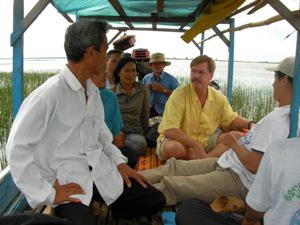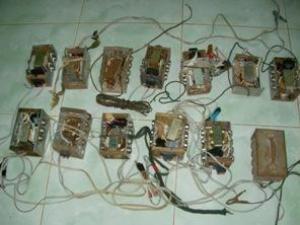Kesaro Loeung
The overall aim is to empower the locally elected community fishery management committee to improve wetland conservation by establishing a fish sanctuary where there is no human use to crate a safe ground for economically important wild aquatic living organisms to generate and a habitat for a number of globally threatened waterfowl species.

A visit to a newly established fish sanctuary (Lou Suong). Taken on 20 Sept 08 in TT reservoir
The Trapeang Thma Wetlands is an internationally significant biological diversity conservation area. The Cambodian government issued a royal degree to conserve the area in 2000, after it was discovered to be home to at least 14 internationally endangered and global threatened wildlife species listed below. However, the government has no capacity to employ staff on the ground to monitor or enforce the law. The local community wishes to establish a wetland sanctuary where there is no human use, to establish a safe ground for these critical wildlife species to feed and breed. By having the sanctuary established, demarcated, monitored and patrolled by local community members, those wild aquatic resources can reproduce and regenerate all year round. Fish and other wild aquatic resources not only serve as a source of income and human food but also significantly reduce dependency of local households on those endangered species and provide those endangered species with increased food sources as well.

Electrocution devices confiscated by the community fishery management committee in coop with local authority.
Internationally endangered Grus antigone, Important Dendrocygna javanica, Sarkidornis melanotus, Anastomus oscitans, Ephippiorhynchus asiaticus, Globally threatened/near-threatened Houbaropsis bengalensis, Pseudibis davisoni, Leptoptilos dubius, Haliacetus leucoryphus,Globally threatened primate Macaca fascicularis; ungulate Cervus eldii; and turtles Cuora amboinensis, Malayemys subtrijuga, and Indotestudo elongate.
With this Rufford Grant support, the local community fishery, especially the five elected management committee members representing villagers at the commune level, will carry out the following activities during 12 months:
(i) organizing concerned stakeholders consultations to discuss the newly proposed communal wetlands sanctuary (size and location),
(ii) identifying its administrative boundaries and produce mapping,
(iii) demarcating physical boundaries by putting wooden poles on ground,
(iv) putting signs on the site to raise public awareness to avoid conflicts between insiders and outsiders in term of use and access to the sanctuary,
(v) carrying out public environmental promotional campaign to other community groups to disseminate information and gain their support and participation in the sanctuary,
(vi) conduct local study tour visits to successful community fishery committees sites in the country to exchange experience.